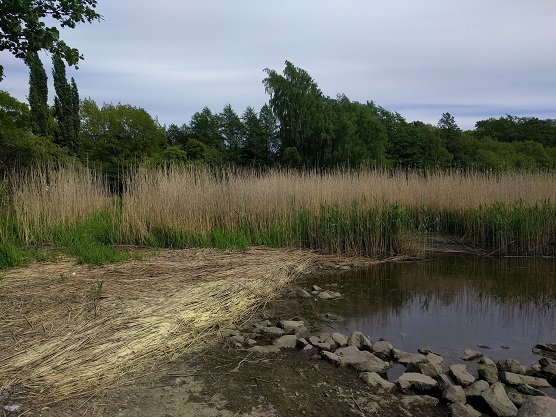Press release 2020-06-11 at 13:01

Pollen washed ashore in Töölönlahti Bay in Helsinki. © Heidi Hällfors/SYKE
The cyanobacterial situation has not notably changed from that of last week; the number of observed cyanobacterial occurrences have merely slightly increased in southern Finland in both Baltic Sea waters and in lakes. All observations concern sparse amounts of cyanobacteria, as is typical for this time of year. In places pine pollen, which misleadingly resembles cyanobacteria, can still be found in the water.
Read more in Finnish
Report your algal bloom observations to the Järvi-meriwiki (Lake and sea wiki)
In the Järvi-meriwiki maintained by the Finnish Environment Institute, everyone has the opportunity to establish their own observation site and share algal bloom observations from lakes and coastal areas. Individual observations can also be sent while navigating different water bodies. You can also report observations using the smartphone-friendly Havaintolähetti website. The reported observations are shown on the national algal situation map, and they support the national algal situation assessment. Observations about the absence of cyanobacteria are also important.
Järvi-meriwiki is an online service produced in collaboration with authorities and citizens. The service provides basic information on all lakes larger than one hectare as well as different areas of the Baltic Sea. Users can share, for example, photos and other observations on the service.
Municipalities and cities monitor the cyanobacterial situation on the beaches, so it is advisable to report rich cyanobacterial blooms on beaches to the health authorities of the municipality in question.
Cyanobacteria observations also in the Itämeri.fi service
This summer, a website on algal bloom observations on the Itämeri.fi service is also launched. The cyanobacterial map presented on this algal bloom observations page combines the observations reported to the Järvi-meriwiki and from the beaches of the City of Helsinki as well as the observations based on satellite interpretations of the Finnish Environment Institute during the last three days.
This is how you identify cyanobacteria
A small amount of cyanobacteria in the water appears as green or yellowish particles. Narrow stripes of algae can drift to a beach. In calm weather, a substantial amount of cyanobacteria forms greenish or yellowish algal rafts and piles up in coastal water. Unlike cyanobacteria, pollen is found not only on the surface water but also, for example, on piers or yard furniture.
If the algae dissolve into tiny particles in the water when you touch it with a stick, it may be cyanobacteria. If the algae attache to the stick, it is something other than cyanobacteria. In a glass of water, cyanobacteria rise to the surface as tiny greenish particles within about an hour.
Algae bloom risk analysis
The risk of cyanobacterial blooms in the Finnish sea areas is considerable or moderate – the summer weather determines the actual situation (Press release June 4, 2020)
Information about algae situation
Pictures
More information
(Telephone 1.00-3.00 pm)
Lakes
- Senior Research Scientist Kristiina Vuorio, Finnish Environment Institute SYKE, Tel. +358 295 251 757, firstname.lastname@ymparisto.fi
Sea areas
Cyanobacterial bloom situation
- Researcher Heidi Hällfors, Finnish Environment Institute SYKE, Tel. +358 295 251 114, firstname.lastname@ymparisto.fi
State of the Baltic Sea
- Research Professor Maiju Lehtiniemi, Finnish Environment Institute SYKE, Tel. +358 40 5034 356, firstname.lastname@ymparisto.fi (until June 12)
- Senior Research Scientist Jouni Lehtoranta, Finnish Environment Institute SYKE, Tel. +358 295 251 363, firstname.lastname@ymparisto.fi (from June 15)
Communications
- Communications Intern Sini Harvo, Finnish Environment Institute SYKE, Tel +358 295 252 184, firstname.lastname@ymparisto.fi